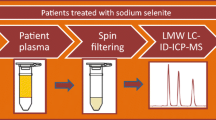Abstract
The analytical methodology for the in vivo study of selenium metabolism using two enriched selenium isotopes has been modified, allowing for the internal correction of spectral interferences and mass bias both for total selenium and speciation analysis. The method is based on the combination of an already described dual-isotope procedure with a new data treatment strategy based on multiple linear regression. A metabolic enriched isotope (77Se) is given orally to the test subject and a second isotope (74Se) is employed for quantification. In our approach, all possible polyatomic interferences occurring in the measurement of the isotope composition of selenium by collision cell quadrupole ICP-MS are taken into account and their relative contribution calculated by multiple linear regression after minimisation of the residuals. As a result, all spectral interferences and mass bias are corrected internally allowing the fast and independent quantification of natural abundance selenium (natSe) and enriched 77Se. In this sense, the calculation of the tracer/tracee ratio in each sample is straightforward. The method has been applied to study the time-related tissue incorporation of 77Se in male Wistar rats while maintaining the natSe steady-state conditions. Additionally, metabolically relevant information such as selenoprotein synthesis and selenium elimination in urine could be studied using the proposed methodology. In this case, serum proteins were separated by affinity chromatography while reverse phase was employed for urine metabolites. In both cases, 74Se was used as a post-column isotope dilution spike. The application of multiple linear regression to the whole chromatogram allowed us to calculate the contribution of bromine hydride, selenium hydride, argon polyatomics and mass bias on the observed selenium isotope patterns. By minimising the square sum of residuals for the whole chromatogram, internal correction of spectral interferences and mass bias could be accomplished. As a result, the tracer/tracee ratio could be calculated for each selenium-containing species and a time relationship for synthesis and degradation established. Both selenite and selenized yeast labelled with 77Se were employed for comparative purposes.









Similar content being viewed by others
References
Gammelgaard B, Jackson M, Gabel-Jensen C (2011) Anal Bioanal Chem 399:1743–1763
Reyes LH, Marchante-Gayon JM, García Alonso JI, Sanz-Medel A (2003) J Anal At Spectrom 18:1210–1216
Reyes LH, Marchante Gayon JM, Garcia Alonso JI, Sanz-Medel A (2003) J Anal At Spectrom 18:11–16
Jitaru P, Goenaga-Infante H, Vaslin-Reimann S, Fisicaro P (2010) Anal. Chim Acta 657:100–107
Jitaru P, Roman M, Cozzi G, Fisicaro P, Cescon P, Barbante C (2009) Microchim Acta 166:319–327
Jitaru P, Prete M, Cozzi G, Turetta C, Cairns W, Seraglia R, Traldi P, Cescon P, Barbante C (2008) J Anal At Spectrom 23:402–406
Jitaru P, Cozzi G, Gambaro A, Cescon P, Barbante C (2008) Anal Bioanal Chem 391:661–669
González Iglesias H, Fernández Sánchez M, Rodríguez-Castrillón JA, García Alonso JI, López Sastre J, Sanz-Medel A (2009) J Anal At Spectrom 24:460–468
González Iglesias H, Fernández Sánchez M, García Alonso JI, Sanz-Medel A (2007) Anal Bioanal Chem 389:707–713
Suzuki KT, Tsuji Y, Ohta Y, Suzuki T (2008) Toxicol Appl Pharmacol 227:76–83
Suzuki KT, Ohta Y, Suzuki N (2006) Toxicol Appl Pharmacol 217:51–62
Suzuki KT, Somekawa L, Kurasaki K, Suzuki N (2006) J Health Sci 52:590–597
Suzuki KT, Somekawa L, Suzuki N (2006) Toxicol Appl Pharmacol 216:303–308
Suzuki KT, Doi C, Suzuki N (2006) Toxicol Appl Pharmacol 217:185–195
Rodriguez-Castrillon JA, Reyes LH, Marchante-Gayon JM, Moldovan M, Alonso JIG (2008) J Anal At Spectrom 23:579–582
Larsen EH, Sloth JJ, Hansen M, Moesgaard S (2003) J Anal At Spectrom 18:310–316
Sloth JJ, Larsen EH (2000) J Anal At Spectrom 15:669–672
Sloth JJ, Larsen EH, Bugel SH, Moesgaard S (2003) J Anal At Spectrom 18:317–322
Berglund M, Wieser ME (2011) Pure Appl Chem 83:397–410
Schomburg L, Schweizer U, Holtmann B, Flohe L, Sendtner M, Kohrle J (2003) Biochem J 370:397–402
Kato T, Read R, Rozga J, Burk RF (1992) Am. J Physiol 262:G854–G858
Avissar N, Ornt DB, Yagil Y, Horowitz S, Watkins RH, Kerl EA, Takahashi K, Palmer IS, Cohen HJ (1994) Am. J Physiol 266:C367–C375
Hill KE, Zhou JD, McMahan WJ, Motley AK, Atkins JF, Gesteland RF, Burk RF (2003) J Biol Chem 278:13640–13646
Ogra Y, Ishiwata K, Takayama H, Aimi N, Suzuki KT (2002) J Chromatogr B Analyt Technol Biomed Life Sci 767:301–312
Acknowledgements
We would like to thank PharmaNord for supplying of the 77Se enriched yeast, Marisa Fernández Sánchez for the supply of the 74Se spike and Teresa Fernández and Agustín Brea from the Biotery of the University of Oviedo for their help regarding animal experiments. Funding from the Spanish Ministry of Science and Innovation through project number CTQ2009-12814 and the Education and Science Council of the Principado de Asturias (grant BP07-059) are gratefully acknowledged.
Author information
Authors and Affiliations
Corresponding author
Rights and permissions
About this article
Cite this article
Lunøe, K., Martínez-Sierra, J.G., Gammelgaard, B. et al. Internal correction of spectral interferences and mass bias for selenium metabolism studies using enriched stable isotopes in combination with multiple linear regression. Anal Bioanal Chem 402, 2749–2763 (2012). https://doi.org/10.1007/s00216-012-5747-7
Received:
Revised:
Accepted:
Published:
Issue Date:
DOI: https://doi.org/10.1007/s00216-012-5747-7




